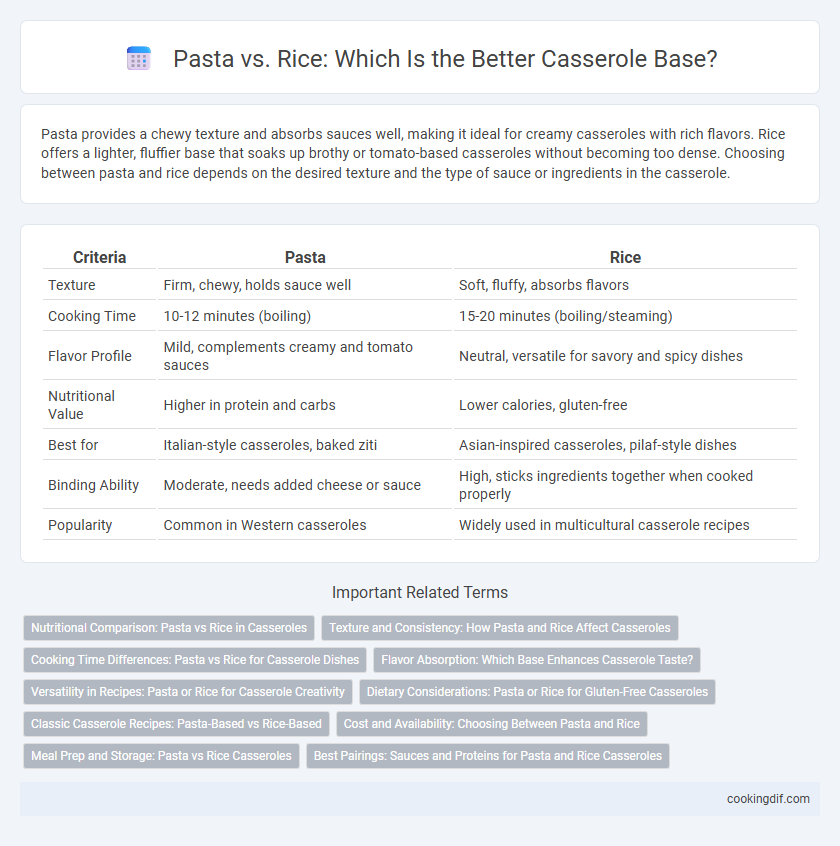Pasta provides a chewy texture and absorbs sauces well, making it ideal for creamy casseroles with rich flavors. Rice offers a lighter, fluffier base that soaks up brothy or tomato-based casseroles without becoming too dense. Choosing between pasta and rice depends on the desired texture and the type of sauce or ingredients in the casserole.
Table of Comparison
| Criteria | Pasta | Rice |
|---|---|---|
| Texture | Firm, chewy, holds sauce well | Soft, fluffy, absorbs flavors |
| Cooking Time | 10-12 minutes (boiling) | 15-20 minutes (boiling/steaming) |
| Flavor Profile | Mild, complements creamy and tomato sauces | Neutral, versatile for savory and spicy dishes |
| Nutritional Value | Higher in protein and carbs | Lower calories, gluten-free |
| Best for | Italian-style casseroles, baked ziti | Asian-inspired casseroles, pilaf-style dishes |
| Binding Ability | Moderate, needs added cheese or sauce | High, sticks ingredients together when cooked properly |
| Popularity | Common in Western casseroles | Widely used in multicultural casserole recipes |
Nutritional Comparison: Pasta vs Rice in Casseroles
Pasta and rice serve as popular bases for casseroles, each offering distinct nutritional profiles. Pasta is typically higher in protein and complex carbohydrates, providing sustained energy, while rice, especially brown rice, offers more fiber and essential minerals like magnesium and selenium. Choosing between pasta and rice depends on dietary goals, with pasta supporting muscle maintenance and rice promoting digestive health.
Texture and Consistency: How Pasta and Rice Affect Casseroles
Pasta provides a firm, chewy texture that absorbs sauces while maintaining its shape, resulting in a structured casserole with a balanced consistency. Rice, particularly short-grain varieties, offers a softer, creamier texture that melds ingredients together, creating a more cohesive and comforting dish. Choosing between pasta and rice as a casserole base significantly impacts the final dish's mouthfeel and sauce integration.
Cooking Time Differences: Pasta vs Rice for Casserole Dishes
Pasta typically cooks faster than rice, with most varieties requiring 8 to 12 minutes of boiling, while rice often needs 18 to 25 minutes depending on the type, such as long-grain or basmati. This time difference significantly affects casserole preparation, as pasta-based casseroles can be assembled and baked more quickly, making them ideal for faster meals. Rice-based casseroles demand longer cooking or pre-cooking time, providing a chewier texture and the ability to absorb sauces more deeply, enhancing flavor complexity.
Flavor Absorption: Which Base Enhances Casserole Taste?
Pasta tends to absorb sauces and seasonings more effectively than rice, enriching the overall flavor profile of casseroles. Rice, while lighter and fluffier, often acts as a neutral base, allowing toppings and sauces to dominate the taste. Choosing pasta as a casserole base enhances flavor absorption and creates a richer, more cohesive dish.
Versatility in Recipes: Pasta or Rice for Casserole Creativity
Pasta offers a versatile base for casseroles, absorbing flavors from sauces and seasonings while providing varied textures with shapes like penne, shells, or fusilli. Rice enhances casseroles by delivering a hearty, chewy texture that pairs well with diverse ingredients such as vegetables, meats, and cheeses, adapting easily to different culinary styles like Mediterranean or Asian-inspired dishes. Both pasta and rice expand creative possibilities, allowing for customizable casseroles that cater to specific taste preferences and dietary needs.
Dietary Considerations: Pasta or Rice for Gluten-Free Casseroles
Rice is a superior choice over traditional pasta for gluten-free casseroles, as it naturally contains no gluten, reducing the risk of allergic reactions or sensitivities. Gluten-free pasta alternatives, often made from rice, corn, or quinoa, can be used but may alter texture and flavor compared to classic pasta varieties. Opting for rice ensures a safe and versatile base, especially for individuals with celiac disease or gluten intolerance, while maintaining the casserole's structural integrity and taste.
Classic Casserole Recipes: Pasta-Based vs Rice-Based
Classic casserole recipes often use pasta or rice as the base, each bringing unique textures and flavors. Pasta-based casseroles, such as macaroni and cheese or tuna noodle casserole, offer a hearty, chewy consistency that absorbs sauces well, enhancing richness. Rice-based casseroles, like chicken and rice bake or jambalaya, provide a lighter, fluffier texture that pairs perfectly with creamy or spicy ingredients, making them versatile and satisfying.
Cost and Availability: Choosing Between Pasta and Rice
Pasta generally offers a more affordable and widely available option for casserole bases compared to rice, especially in regions with strong Western culinary influences. Rice prices can fluctuate significantly based on variety and import sources, impacting overall dish cost and accessibility. Pasta's consistent pricing and ubiquitous presence in grocery stores make it a cost-effective and convenient choice for casserole recipes.
Meal Prep and Storage: Pasta vs Rice Casseroles
Pasta casseroles offer a versatile and quick base that holds up well in meal prep, maintaining texture and flavor after reheating better than rice. Rice casseroles, while often lighter and gluten-free, can become mushy or clump together during storage, requiring careful moisture control to preserve quality. Choosing pasta enhances reheating convenience and consistency, making it ideal for large-batch casseroles that need reliable storage and meal portioning.
Best Pairings: Sauces and Proteins for Pasta and Rice Casseroles
Pasta casseroles excel with rich tomato-based sauces and hearty proteins such as ground beef or Italian sausage, enhancing the dish's robust flavors. Rice casseroles pair best with creamy or curry sauces alongside tender chicken or seafood, which absorb the sauces deeply for a moist texture. Both bases benefit from complementary herbs and cheese, but the choice depends on the desired flavor profile and sauce consistency.
Pasta vs rice for casserole base Infographic

 cookingdif.com
cookingdif.com